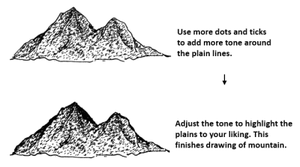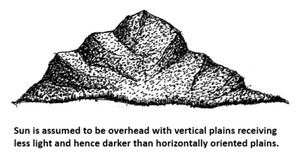Another approach to drawing mountains is to focus on its surface imperfections. The surface of a mountain has many cuts representing imperfections and in this technique for drawing mountain focus is on drawing such cuts to convey feel of mountain. Following is the shape of a surface cut in perspective. Most important thing to understand is that it is tapered and starts and ends in a point.
How to Draw Mountain
In this page, I will show how to draw mountains. There are many ways of drawing mountains and I will describe few techniques here. Each technique gives a different feel for the mountain and is appropriate for drawing different type of landscapes. Pen and Ink is used as the drawing medium in tutorial below, but same concepts can be used with other mediums as well.
There are essentially two main types of techniques for drawing mountains. In one set of techniques, a simple, typical outline is used with focus on creating plains from the edges of the mountain. In another set of techniques, focus is on creating more interesting cuts and crevices on the body to draw a mountain. We start by learning how to draw mountain with different plains and then move on to creating more interesting cuts and crevices on the body.
Drawing Mountain: Defining Plains
In this approach, draw an outline of mountains with distinct change in angle. These are called transition points. From here draw lines to create plains as shown below.

Drawing Mountain: Texturing
Once plains are drawn, they need to be brought out and given form to give overall form to the mountain. There are 2 aspects to it as following
- Stroke used to texture
- Shading using the stroke to give form/depth
Simplest stroke to use for texturing mountain is dots and ticks. In addition, use different density of the stroke to highlight different plains as shown below.

Above is a simple but very effective technique for shading where plain lines and small surrounding areas are slightly darkened to give form to the plains. In more involved approach, direction of light (Sun) is assumed and plains/surfaces facing the light source are shaded lightly compared to surfaces away from the light source. This is explained in detail in my workbook. Following is another useful approach where Sun/light source is assumed to be overhead resulting in vertical plains being darker than horizontally oriented plains.

By using different outlines, mountains with very different feel can be drawn using this technique. Parallel lines is another way to texture mountains in this technique as shown below. This is discussed in detail in my workbook.
Learn to Draw Mountains and Mountain Landscapes
If you like to paint landscapes, it is useful to look at how to draw mountains. This online tutorial shows how to illustrate rocks and mountains and thus also the method of drawing mountain landscapes.
Mountains are very often part of landscape paintings and drawings. However, the representation of mountains and rocks is a problem for many hobby drawers. Quite often I hear or read the question: How do I draw mountains? But a mountain is not that difficult to depict and it is no matter the medium you use.
A graphical observation of a mountain
When you look at a mountain graphically, you can see that a mountain consists of a characteristic contour, structure and shadow. If you paint mountain landscapes with colored pencils, oil or acryl colors, the composition in terms of color comes into play.
Consider each of these four aspects individually.
Drawing of mountains
Contour of a mountain
The contour of a mountain represents simply its outline. The artistic tool in this case is the line. We all know how mountains look like – most of them run together to the peak. The mountain usually does not stand alone in the landscape and consists only of one peak. Most of the mountains ad up to a whole mountain landscape and have several higher or lower peaks.
A single mountain with a peak is more characteristic of volcanoes. The mountains as we find them in the Alps are not caused by volcanic activity, but by the clashing of tectonic plates. For this reason, the mountain’s crest extend over a greater distance and form whole mountains.
If you want to bring a change in the drawing of a mountain landscape, the top of a mountain can sometimes also flattened – some mountains also look like this.
If you would like to learn more about the theory of the emergence of the Alps, here is some information: history of the Alps
Illustration of the contour of several mountains
Structure of mountains and rocks
Another characteristic of a mountain is its structure. From an artistic point of view, the structure is a design element as well. We can represent them with different lines.
Mountains generally have an angular structure. The edges are formed by the straight fractured surfaces typical of stone and rocks. We draw rocks of a mountain with a suitable angular structure. Thus you can already draw a clearly recognizable mountain landscape through the structure in combination with the contour.
Illustration of the structure of mountains and rocks
Draw shadows of a mountain
The next step in drawing mountains is to sketching of shadows. Shadows can be realized with any drawing technique.
When drawing the shadows you have to observe the shape of the rocks of the mountain. The various rocks that stand out of the mountain throw also shadows on each other. With the correct representation of these shadows, you create the three-dimensional form of rock and mountain is.
Drawing these shadows is probably the most difficult part when drawing mountains. An artist, who often depicted rocks and mountains in his works, was Caspar David Friedrich – a German painter of the Romatic.
Shading of a mountain
Color design of mountains
As for color design it is noticeable that mountains have a strong blue tinge. This is true at least for mountains, which lay in very far distance.
The blue hue comes through the air between the viewer and the mountain. This perspective effect is also known as the aerial perspective.
Tips mountains, mountain landscapes and rocks
These were my tips in this online drawing guide for drawing mountains, mountain landscapes and rocks. In the other tutorials, you’ll learn more about drawing landscapes and drawing techniques.
About this Website
This website is about how to draw and paint. You will learn to use pencil and brush and how to drawn and paint your own pictures.





